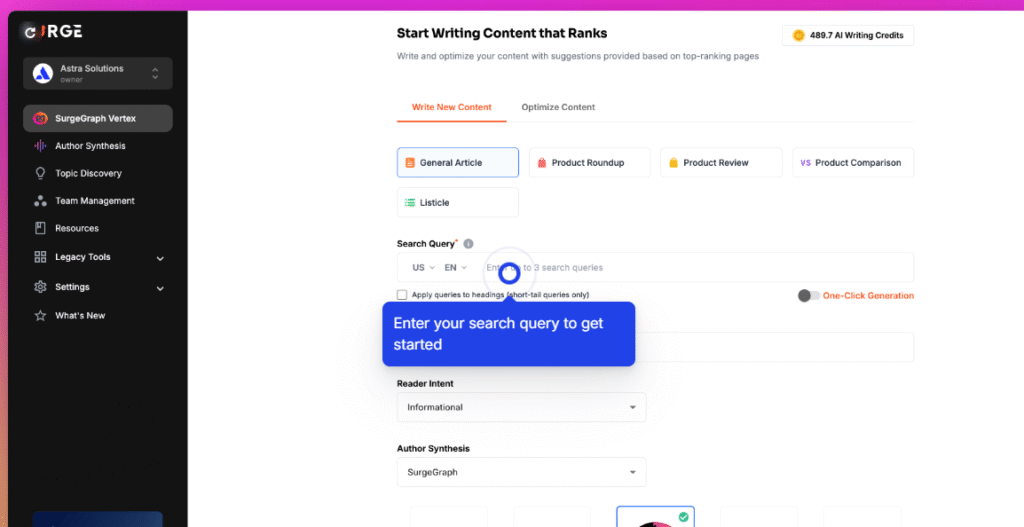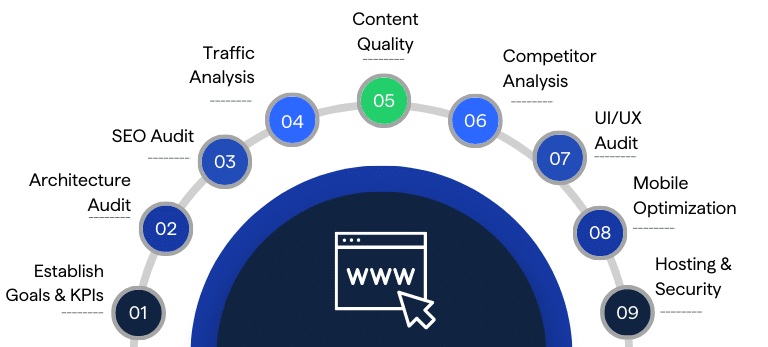How to Use AI for Content Creation: 5 Highlights from SurgeGraph’s AMA
Discover key takeaways from SurgeGraph’s AMA with Chris Fulmer and Kevin Blumer on how to use ai for content creation effectively.
October 6, 2025

Chris Fulmer and Kevin Blumer from The Brand Auditors joined SurgeGraph’s Facebook community for a live AMA (Ask Me Anything) to share the behind-the-scenes strategies used by The Brand Auditors to audit our client’s content.
The content team at The Brand Auditors uses SurgeGraph to show clients how to create content that performs—despite Google’s algorithm updates.
Chris and Kevin answered questions on everything from how to structure a content team, to what Google looks for in AI-generated content, to how tools like SurgeGraph can identify content gaps.
This post includes the key takeaways from that AMA—including real examples, process breakdowns, and actionable tips you can apply to your own content strategy.
But first, we’d like to tell you more about SurgeGraph.
What is SurgeGraph and why should marketing leaders use it for AI content creation?
Market leadership is synonymous with digital dominance. For CMOs and marketing directors of enterprises, every investment must contribute to the bottom line.
A content marketing strategy can be challenging when it comes to ROI and scalability. The key is to transform your content operation from a perceived cost center into a predictable revenue engine.
SurgeGraph is an AI-powered content intelligence and generation platform engineered to meet this challenge. It offers a strategic framework to ensure your content establishes your brand’s authority in the market.

Align Content with C-Suite Objectives
For a large organization, content must be a strategic pillar. SurgeGraph provides the tools to:
Drive revenue and market share: Go beyond vanity metrics. SurgeGraph’s in-depth SERP and competitor analysis uncovers high-potential, low-competition topic clusters, allowing you to strategically target areas where you can dominate the conversation and capture valuable search traffic. This data-driven approach ensures your content efforts are directly tied to tangible business outcomes.
Guarantee brand consistency at scale: In a global enterprise, maintaining a consistent brand voice across dozens of writers and marketers is a significant hurdle. SurgeGraph’s Author Synthesis and Knowledge features allow you to train the AI on your specific brand guidelines, proprietary data, and unique market positioning.
Optimize your Martech ROI: Your technology stack should empower, not encumber. SurgeGraph integrates into your existing workflow, offering features like Team Management, customizable Flex Workflows, and Whitelabel Reporting. This streamlines the entire content lifecycle, from ideation to publication and reporting, maximizing the efficiency of your team and the return on your technology investments.
A Solution for Enterprise-Level Challenges
SurgeGraph is built to address the specific pain points of large-scale content operations:
Scalability without sacrificing quality: The pressure to produce a high volume of quality content is immense. With Bulk Content Generation and customizable AI workflows, you can rapidly scale your output while maintaining the highest standards of quality and brand alignment.
Break down organizational silos: Foster collaboration and efficiency across your marketing department. SurgeGraph’s team management features and shareable links create a unified environment for content strategy, creation, and approval, eliminating bottlenecks and ensuring everyone is working towards the same strategic goals.
Demonstrate a clear return on investment: Justify your content marketing budget with clear, concise data. SurgeGraph provides the analytics and reporting tools necessary to track the performance of your content and its direct impact on lead generation, customer acquisition, and revenue growth.
SurgeGraph provides the strategic intelligence and operational efficiency required to elevate your content marketing from a tactical function to a core driver of business growth. It’s time to empower your team with a platform that understands and delivers on the metrics that matter most to your executive leadership.
Now, let’s get to the Q&A.
How to use AI for content creation: Q&A
In the following sections, we’ve summarized the answers Chris and Kevin gave during SurgeGraph’s Ask Anything session.
How do you develop effective workflows and structure for a content team?
One of the biggest challenges we see across companies is a disconnect between the SEO team and content writers. SEO is focused on rankings and traffic. Writers want to create engaging, well-written pieces that convert.
But when these two efforts aren’t aligned, quality—and results—suffer.
That’s why companies need a content or marketing manager who understands SEO and editorial quality.
Here’s an example of a powerful content creation workflow:
SEO Team: Conducts keyword research and identifies topics that align with business goals and search intent.
- Content Manager: Translates SEO insights into a clear, structured content brief.
- Writer: Drafts the piece, optimizing it for readability and SEO.
- Manager (again): Edits the piece to ensure brand consistency, content purpose, and quality before publishing.
- SEO Team: Tracks performance and reports back every 90 days to reassess content impact.
- Team size varies based on how much content you’re producing, but here’s a useful benchmark: a single editor can only review a few posts a day. More than that, and details start slipping—leading to the #1 cause of poor quality control.

Where does Google draw the line with AI content?
Google is cracking down on low-value, AI-generated content. But the line between helpful and spammy isn’t always clear.
The truth?
Most AI-generated content is too generic to stand out. This is especially true for technical or niche topics.
In our own work, we often end up rewriting half or more of what AI produces. It’s not because the grammar is wrong. The AI lacks originality, depth, and point of view.
So, where’s the line?
Google rewards expertise, authority, and trustworthiness (E-E-A-T).
For example, if a certified doctor and a wellness blogger write the same post on high blood pressure, the doctor’s post will rank higher—even if the content is similar. The same principle applies to brands.
It’s crucial to share your expertise, offer proven advice, and deliver genuine value.
One tool we’ve found useful here is SurgeGraph’s topical coverage feature. It surfaces angles we may not have considered, helping us avoid repetition and add depth.
How do content creators use AI without triggering the Scaled Content Penalty?
We use AI a lot—but with structure and strong editorial oversight.
In one example, we published a post on advanced Google Ads strategies that ranks in the top 10 for its target keyword.
The original draft was AI-generated. But we heavily edited it to reflect our voice and include tested, real-world insights.
It has performed well because the content is authentic and valuable.
That said, AI makes it easy to get lazy. You get used to its tone, pacing, and phrasing—and before long, you stop questioning it. That’s when “AI-isms” creep in. Examples are vague intros, repetitive phrasing, or content that sounds helpful but says nothing.
To gain a competitive edge, use high editorial standards when others don’t. AI will improve. But right now, quality wins.
What is the content audit process? What are you looking for?
Our content audit process is designed to be strategic and actionable. Here’s how we break it down:
1. Performance assessment
We start by finding the best performing and worst performing pages. Then, we look for patterns.
2. Content mapping by funnel stage
Each post is mapped to a stage in the customer journey—awareness, consideration, or decision. We check for gaps and make sure key topics are supported at each stage with internal links.
3. Search intent and keyword alignment
We analyze whether the post’s primary keyword aligns with the intent of the customer journey stage. Mismatched intent is a common cause of underperformance.
4. Optimization review
We evaluate:
- Titles, H1s, and meta descriptions
- Heading structure and internal linking
- URL structure and keyword placement
5. Authority and trust
Each piece of content should prove expertise. It should also demonstrate expertise.
In addition, content should have links to credible sources, especially when referencing statistics or facts.
As we have already mentioned, content written or reviewed by someone with authority will carry more weight than content written by a novice of anonymous source.
6. Technical Health
Even the best content can underperform if the page’s technical foundation isn’t solid. So, we include a technical health check as part of our audit process. These may seem like small details, but together, they have a big impact on user experience and search rankings.
Here’s what we look for:
- Page speed: If your page takes too long to load, users leave—and search engines notice. We check for any bottlenecks (like large images, unoptimized scripts, or render-blocking elements) and look for ways to streamline the page so it loads quickly across all devices. Aim for 2.5 seconds or under.
- Broken links: Dead links create a frustrating experience for users and can signal poor maintenance to search engines. We run a scan to identify and fix any internal or external links that lead to 404 pages or redirect loops.
- Alt text for images: Alt text isn’t just for accessibility—it also helps Google understand your images, which can contribute to image search visibility. We check that every image has descriptive, keyword-relevant alt tags that add value without keyword stuffing.
- Mobile responsiveness: With most traffic now coming from mobile devices, responsive design is a must. We test pages across multiple screen sizes to make sure content displays cleanly and functions properly—no cut-off text, overlapping elements, or awkward navigation.
Fixing these issues can dramatically improve performance, especially for older posts that haven’t been updated in a while. Think of it as tuning up your car—you’re not changing the engine, just making sure it runs smoothly.

7. Topical Coverage
We assess whether the content covers the topic thoroughly enough to meet user expectations and search intent.
If the coverage is too shallow or overly broad, we consider expanding the post with more in-depth insights, examples, or supporting information. In some cases, if the topic includes multiple subtopics or complex ideas, it may make more sense to break it into two or more focused posts to improve clarity and ranking potential.
How do you perform content competitor analysis?
Competitor analysis is much more than analyzing the top three search engine results pages. The goal is to uncover content gaps, quality differences, and missed opportunities.
Here’s a condensed version of our process:
1. Define Real Competitors
Look beyond industry rivals. Competitors include alternatives and substitutes, not just companies like yours. For example, a CRM competes with spreadsheets too.
2. Analyze Content Types
What types of content dominate the top 10 for your target keywords? How-to guides, comparison pages, video content?
3. Identify Gaps
We use SEMrush and Ahrefs to identify high-traffic competitor pages we’re not matching. Then, we use SurgeGraph to analyze topical completeness and content depth.
4. Evaluate Domain Strength
Who links to them? How strong is their backlink profile?
5. Compare E-E-A-T
Do they do a better job at establishing authority, showcasing credentials, or earning trust?
6. Content Distribution
Where are they sharing content? Are they dominating one platform you’re ignoring?
7. Exploit Weaknesses
We dig into:
- Questions competitors aren’t answering
- Content that’s outdated or shallow
- Gaps in funnel coverage
- Poor user experience or technical SEO issues
Then, we counter with superior structure, deeper insights, faster loading pages, and stronger intent alignment.
Final thought: Your process is your advantage
Most companies fail at content not because they lack ideas, but because they lack structure. A great content strategy isn’t just a list of keywords or a calendar—it’s a system of quality control, expertise, and audience alignment.
When you get that right—and when you layer in tools like SurgeGraph strategically—you give yourself an edge your competitors can’t easily copy.
Ready to Turn Insights into Action?
If you’re serious about building content that stands out—even as Google’s algorithms change—now is the time to level up your process. Don’t settle for guesswork or generic advice. Take advantage of the actionable strategies and real-world tips we shared during our SurgeGraph AMA.
Here’s what you can do next:
- Review the AMA highlights above and put our workflow, auditing, and competitor analysis tips into practice.
- Try SurgeGraph for your next article to see firsthand how it can help you develop better content, boost your rankings, and simplify your process—no matter your team size or experience level.
- Have a question or want expert feedback? Connect with The Brand Auditors, or reach out for a personalized content audit.
Ready to grow your brand?
Connect with a strategist to uncover your biggest opportunities and map out a clear path forward.

POST AUTHOR
Core services
Digital marketing
audit services
Discover how to improve marketing campaigns, strengthen the impact of every customer touchpoint, and focus resources on the actions that generate more revenue.
Customer experience strategy consulting
Turn raw customer data into audience personas and laser-focused messaging.
